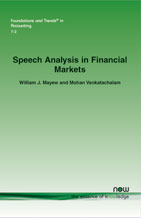Speech Analysis in Financial Markets
William J. Mayew, Duke University, Fuqua School of Business, USA, william.mayew@duke.edu , Mohan Venkatachalam, Duke University, Fuqua School of Business, USA, mohan.venkatachalam@duke.eduAbstract
The ways in which managers communicate information to capital market participants go far beyond financial statements and accounting numbers. Managers communicate economically relevant information both verbally, in documents distributed and available to investors (such as annual reports and SEC filings), and nonverbally, through meetings and conference calls with analysts and investors. We review research on the information contained in nonverbal communication, particularly vocal communication that occurs in organizational contexts. We also explore possible ways in which accounting researchers can draw useful insights from investigating managerial vocal communication. The advances in computerized voice analysis coupled with the increasing availability of audio files containing managerial communication presents promising research opportunities.
Speech Analysis in Financial Markets
The ways in which managers communicate information to capital market participants go far beyond financial statement numbers. Managers communicate economically relevant information both verbally, in documents distributed and available to investors, and non-verbally, through meetings and conference calls with analysts and investors. Over the past five years, the advances in computational linguistic software and the availability of large repositories of corporate text have facilitated an explosion of studies examining the information contained in verbal communication from management.
Speech Analysis in Financial Markets reviews research on the information contained in nonverbal communication that occurs in organizational contexts and explores ways in which accounting researchers can draw useful insights from investigating managerial nonverbal communication. It focuses on non-verbal communication from voice with a particular emphasis on discussing voice analysis from the standpoint of a researcher interested in conducting empirical archival assessments. After an introduction, section 2 discusses the research approaches to speech analysis and the importance of identifying speech corpus. Section 3 reviews the existing literature on voice analysis in accounting and finance primarily focused on management communication. Section 4 details the challenges to the literature, and offers some directions for future research, and section 5 offers concluding remarks.
